Status Active | In use 1946–present | |
 | ||
Type Aerospace (military/civil) Nuclear tests 9 (See British nuclear tests at Maralinga and Operation Totem) Operator Royal Australian Air Force's Air Warfare Centre Other tests Missiles, aircraft weapons, drone aircraft, rockets Similar Broglio Space Centre, Svobodny Cosmodrome, Island Lagoon Tracking, Pine Gap, Emu Field - South Australia | ||
The RAAF Woomera Test Range (WTR, previously known as the Woomera Test Facility, the Woomera Rocket Range, and the Long Range Weapons Establishment, Woomera) is a weapons testing range operated by the Royal Australian Air Force (RAAF) Air Warfare Centre. The day-to-day operation and administration of the WTR is the responsibility of Headquarters, RAAF Woomera Test Range, based at RAAF Base Edinburgh. The range facility is located in South Australia, in that State's north-west pastoral region. The gateway to the Range is the Defence support base Woomera long referred to as 'Woomera Village'. Woomera is located approximately 500 kilometres (310 mi) north-west of Adelaide. The Range, however, covers a large area, and is the largest land-based weapons test facility in the western world.
Contents
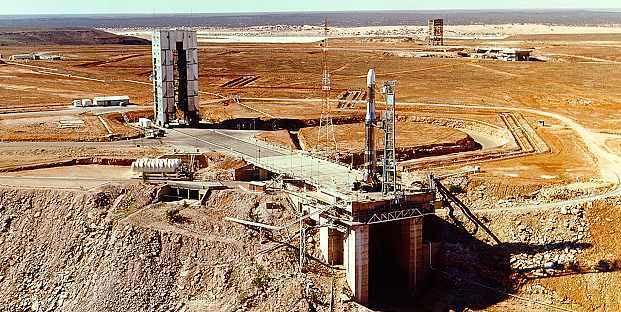
The range complex is made up of the Woomera Prohibited Area (WPA, the groundspace of the range), the Woomera Restricted Airspace (WRX, the associated airspace), the village of Woomera, RAAF Woomera Airfield, and Camp Rapier (the former Woomera Immigration Reception and Processing Centre). The nearby Nurrungar Test Area Woomera (NTAW), which was the former site of the USAF/ADF Joint Defense Facility Nurrungar, is now also part of the wider Woomera Test Range complex. Woomera village has a usual population of 150 to 200 people, but can provide accommodation and services for up to 500 range users per day. Although the range is closed to the public, Woomera village is open to the public.
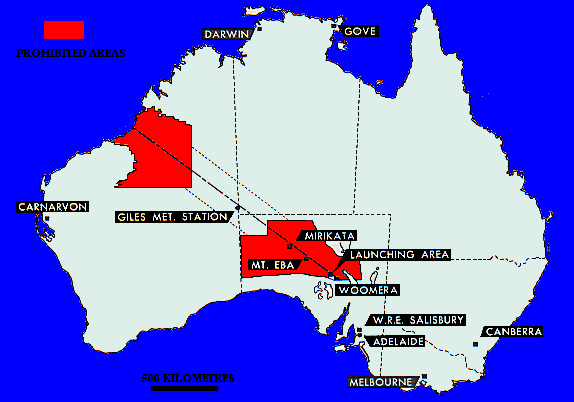
Woomera Prohibited Area
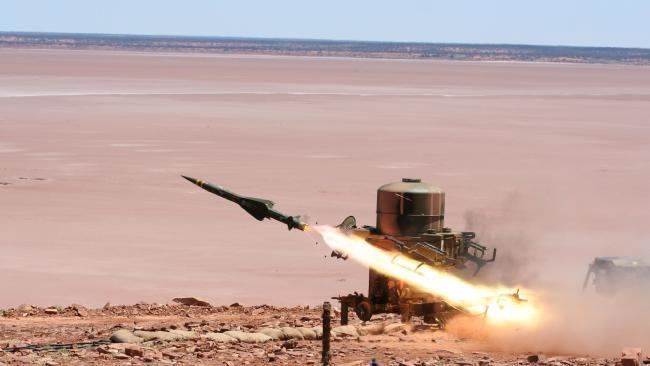
The groundspace of the range is known as the Woomera Prohibited Area and measures 122,188 km2. It was first declared a prohibited area in 1947. Access is managed by the Department of Defence Woomera Prohibited Area Coordination Office using a permit system. Non-defence users of the area include pastoralists, aboriginal people and traditional owners, mining and exploration companies with leases in the WPA (including Arrium and OZ Minerals), opal miners, tourists, research organisations and the rail operator, Genesee & Wyoming Australia.
Mining

Modern mines within the area include the Challenger gold mine, Peculiar Knob iron ore mine, Prominent Hill copper mine and the Cairn Hill iron ore mine. As of 2016, only Challenger is operational. Peculiar Knob is in care and maintenance owing to a weak iron ore price, while ore bodies at Prominent Hill and Cairn Hill have been exhausted.
Woomera Prohibited Area Advisory Board
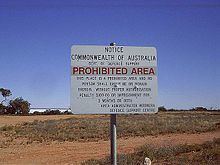
A Woomera Prohibited Area Advisory Board exists to "monitor and recommend amendments to co-existence policies and procedures; develop high-level relationships between Defence and the resources sector; resolve disputes between Defence and non-Defence users; report annually on the balance of interests in the WPA; and conduct a review every seven years of the balance of interests in the WPA."
As of 2016, WPA Advisory Board membership includes:
Minutes of the Board from 2012–2016 were partially released following a Freedom of Information request in 2016.
Tourism
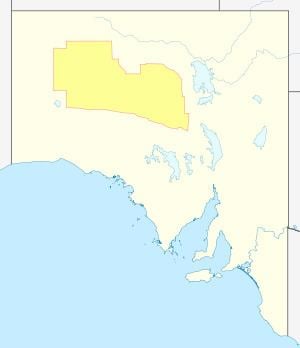
The historic precinct of the town attracts a large number of visitors each year to view the many local attractions including the Missile Park, Heritage Centre, History Museum and other attractions such as Butement Square, the Eldo Hotel (formerly the headquarters for European Launch Development Organisation), and the local observatory. Approximately 65,000 tourists a year visit Woomera, with about half of that number going on to visit Roxby Downs (location of the BHP Olympic Dam Mine).
History
Germany's use of V-1 flying bombs and V-2 rockets during World War II prompted the British to establish their own rocket testing programme. However, the density of population in the United Kingdom made testing risky, so the British turned to Australia, asking for a site with a long testing corridor containing minimal population. The two nations joined in the Anglo-Australian Joint Project, a Commonwealth weapons design and test programme established in 1946. Surveying the 1400 mile range from Woomera to the far north coast of Western Australia was initially conducted by the Army's Australian Survey Corps under Trevor Nossiter from 1946 in South Australia's Far North. One of the Survey Corps members who commenced work there in 1947 was Len Beadell. Australia was responsible for providing the testing facilities, personnel, and most of the funding, while the United Kingdom supplied most of the scientific equipment and personnel, and in addition to its financial contribution, paid for the weapons being used. The name of the facility, and the village of Woomera, came from the Aboriginal spear-throwing device. At its peak, the range had an area of 270,000 square kilometres (100,000 sq mi), most of which was in South Australia, but included a satellite range in north-west Western Australia. This was later scaled back to a total area of 127,000 square kilometres (49,000 sq mi); still the largest land-based weapons test range in the western world.
Facilities at Salisbury, South Australia supported the design and testing of many weapons and Upper Atmospheric Experiments trialled at Woomera. Weapons designed by the Joint Project and tested at Woomera include the Sea Wolf, Rapier, Sea Dart, and Bloodhound surface-to-air missiles, the Black Knight research rocket, the Blue Steel nuclear stand-off missile, the Malkara anti-tank missile, the Ikara anti-submarine missile, and the GAF Jindivik target aircraft. Missile testing commenced in 1949. The Joint Project ran until 1980.
After the cancellation of the Joint Project the range was operated by Defence Research Centre Salisbury (former Weapons Research establishment, now Defence Science and Technology Organisation) in support of Australian Defence projects as they arose and also in support of German and NASA Sounding Rocket launches to observe the Supernova 1987A and other astronomical experiments. Woomera then focused on supporting the nearby joint Australia-United States Joint Defence Space Communications Station, Nurrungar. The surveillance facility closed in 1999, around the same time the Defence Science and Technology Organisation and the RAAF's Aircraft Research and Development Unit identified the future potential for the Range, particularly as it was one of the few sites in the world where over-the-horizon weapons testing was feasible.
As of the end of 2009, there were up to ten different tests occurring on the range daily, and bookings for access had been made as far in advance as 2023. The increase in interest from other parties prompted the Australian government to mark $500 million in funding for Woomera in May 2009, to update tracking systems and other infrastructure.
In June 2010, the Japanese space probe Hayabusa landed on the Woomera test range after visiting the asteroid 25143 Itokawa.
In 2011 Federal Defence Minister Stephen Smith and Resources Minister Martin Ferguson, together with South Australian Premier Mike Rann, announced that large areas of the Woomera Protected Area would be opened up for mining. This followed years of negotiations for the "mixed use" of the area, which contains many billions of dollars of mineral resources.
In 2013 testing began on Taranis, a drone aircraft which is the result of a joint project between UK defence and BAE Systems.
In June 2016, Raytheon was awarded a $297 million Commonwealth government contract to upgrade the range and make it the world's most advanced test range. The works are intended to accommodate performance tests of the F-35 Joint Strike Fighter and provide access for the United States military.
The range is currently used for Australian Defence Force trials, and access is leased to foreign militaries and private companies for their own testing of weapons systems, rockets, and drone aircraft.
Rocketry
The Woomera range has also been used for rocketry. During the 1950s, the Black Knight rocket (as a component of Blue Streak) was tested at the range. The first rocket launch occurred in 1957, and continued until the last satellite launch, Prospero X-3 in 1971. Australia's first satellite, WRESAT, was launched from Woomera in 1967. The range was awarded a National Engineering Landmark in 1999. Although initially allowed to lapse after the cancellation of the Joint Project, the use of the range for rocket research later increased. In 2002, the University of Queensland launched a rocket carrying the HyShot engine: the first successful flight of a hypersonic scramjet engine.
During the Cold War, Woomera had the second highest quantity and rate of rocket launches in the world after NASA's facilities at Cape Canaveral.
